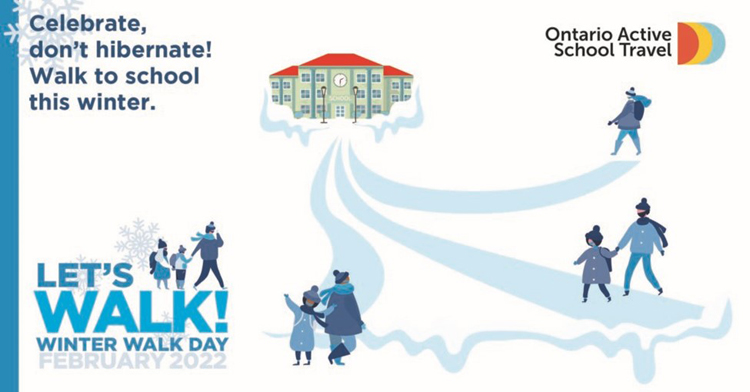Celebrate, don’t hibernate! Walk to school this winter.
Whether we were born in Canada or came here later in life, it seems many of us don’t like Canadian winters. Did you know there is a scientific reason why winters make us feel so lethargic and unhappy?
It turns out the lack of light affects our brain’s ability to generate serotonin and melatonin, two chemicals that help regulate our sleep cycles, energy, and mood. It’s called Seasonal Affective Disorder (SAD). Lack of exposure to full-spectrum natural light also reduces the body’s production of vitamin D, a chemical necessary for calcium absorption. Low vitamin D levels have been linked to many diseases including, breast, colon, and prostate cancers, heart disease, depression and weight gain.
Low levels of vitamin D in children are related to rickets which causes soft, poorly formed bones. Children can also experience SAD and the affects can be similar to clinical depression. This includes negative thinking, changes in sleeping or eating, and lower overall energy. Loss of concentration is another symptom, which may affect the child’s school results.
For many children and teenagers, an effective antidote to SAD and low vitamin D levels is to get outside and absorb the natural light. Even 30 minutes of winter light exposure per day on the face can generate sufficient levels of vitamin D, serotonin, and melatonin.
The World Health Organization recommends children and adolescents aged 6 through 17 get at least 60 minutes of moderate to vigorous exercise daily to maintain healthy bones and muscles. But, according to the Region of Peel, fewer than half of Peel’s kids are getting the minimum amount of daily activity. And 27% are overweight or obese.
Walking or riding to school and back, at least some of the days of the week, may be the simplest and easiest solution to these related problems. It builds physical activity into the child’s daily routine which supports better mental health outcomes, higher concentration abilities and better academic performance.
February is Winter Walk Month and there is no time like the present to put your child on the “Road to Health”! Encourage them to walk or ride. Walk with them if you have the time or join with a group of parents to form a walking school bus or bike train. Who knows, you may find that winters become enjoyable for both you and your family!
What’s walking and riding to school have to do with the environment? Well, 20-25% of Peel’s morning and afternoon vehicle traffic is from children being driven to school. Increasing the amount of walking or riding will decrease vehicular traffic which is the single biggest producer of carbon emissions in Brampton.

